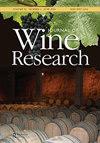Qualitative alcoholic and dealcoholized wine vapor-phase stimuli perceptions using a citation frequency-based method
Q2 Agricultural and Biological Sciences
引用次数: 0
Abstract
ABSTRACT Retronasal and orthonasal wine vapor-phase stimuli perceptions by 57 participants were obtained using a citation frequency-based method. Ariel Chardonnay (35.45%) and Ariel Rouge (35.19%) concentrates were used to create 5 ethanol concentrations (i.e. <0.5% abv, 3.75% abv, 7% abv, 10.25% abv, and 13.5% abv) for each type of wine. Overall, no significant differences were found among Chardonnay wine aromas and Rouge wine aromas. However, an increase in ethanol concentration significantly decreased the response probability for apple (p = 0.030) retronasally and significantly increased the response probability for alcohol (p = 0.013) orthonasally in Chardonnay wine. In Rouge wine, ethanol concentration significantly impacted response probabilities for ginger (p = 0.022) retronasally and bell pepper (p = 0.025) and wood (p = 0.039) orthonasally. Such findings suggest that the contributions of ethanol to the aroma of real wines may be subtle from a consumer perspective and orthonasal and retronasal qualitative descriptions for wines may not be equivalent. With further investigation and some modification, the use of a citation frequency-based method may be used in smell research to collect detailed, qualitative data from consumers or individuals with no or minimal sensory training.基于引用频率的定性酒精和脱醇葡萄酒气相刺激感知方法
摘要采用基于引文频率的方法,对57名受试者的后鼻和正鼻酒气相刺激感知进行了研究。爱丽儿霞多丽(35.45%)和爱丽儿胭脂(35.19%)浓缩液分别为每一种酒配制5种乙醇浓度(<0.5% abv、3.75% abv、7% abv、10.25% abv和13.5% abv)。总的来说,霞多丽葡萄酒和红葡萄酒的香气没有显著差异。然而,乙醇浓度的增加显著降低了苹果(p = 0.030)的反鼻响应概率,显著提高了霞多丽葡萄酒(p = 0.013)的反鼻响应概率。在胭脂酒中,乙醇浓度显著影响生姜(p = 0.022)、甜椒(p = 0.025)和木材(p = 0.039)的正交响应概率。这些发现表明,从消费者的角度来看,乙醇对真正葡萄酒香气的贡献可能是微妙的,对葡萄酒的正鼻和后鼻定性描述可能不等同。通过进一步的研究和一些改进,基于引文频率的方法可以用于嗅觉研究,从没有或很少的感官训练的消费者或个人那里收集详细的、定性的数据。
本文章由计算机程序翻译,如有差异,请以英文原文为准。
求助全文
约1分钟内获得全文
求助全文
来源期刊

Journal of Wine Research
Agricultural and Biological Sciences-Horticulture
CiteScore
2.40
自引率
0.00%
发文量
10
期刊介绍:
The Journal of Wine Research is an international and multidisciplinary refereed journal publishing the results of recent research on all aspects of viticulture, oenology and the international wine trade. It was founded by the Institute of Masters of Wine to enhance and encourage scholarly and scientific interdisciplinary research in these fields. The main areas covered by the journal include biochemistry, botany, economics, geography, geology, history, medicine, microbiology, oenology, psychology, sociology, marketing, business studies, management, wine tasting and viticulture.
 求助内容:
求助内容: 应助结果提醒方式:
应助结果提醒方式:


